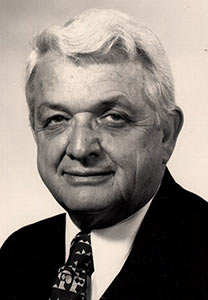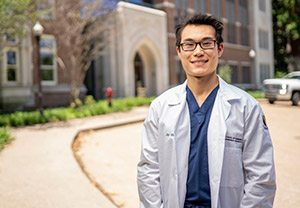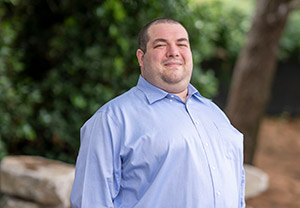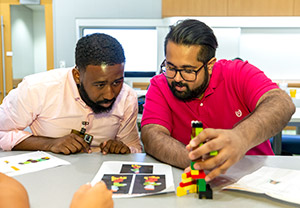When Jay Huang enrolled at Vanderbilt University School of Nursing in 2019, he was well aware of the statistics: Just 9 percent of nurses in the United States are male. Role models may be scarce, but Huang is undeterred. The Californian, who holds an undergraduate degree in biochemistry, found a passion for health care after he did volunteer outreach with older adults for the San Francisco Department of Public Health.
“At the end of the day, I simply want to help people who are in need,” said Huang, who is in the school’s accelerated PreSpecialty program, a rigorous 12-month curriculum designed for students with bachelor’s degrees in areas other than nursing.
The School of Nursing is a national leader in sending men into the profession, becoming in 2018 one of only eight nursing schools in the United States to win the “Best School” honor from the American Assembly of Men in Nursing (AAMN). Following the announcement, the School of Nursing’s male enrollment jumped by 30 percent. In fall 2019, the 65 incoming male students, Huang among them, accounted for 13 percent of all admitted students.
“It’s important for nursing—indeed any profession—to be inclusive. Just as our patients are diverse, nursing needs to be diverse. Research by the Robert Wood Johnson Foundation shows that patients communicate better with providers whom they perceive to be like them,” said Linda D. Norman, DSN, RN, FAAN, dean of the School of Nursing and Valere Potter Menefee Professor of Nursing. “It’s also important for female students to have male classmates. Men have different viewpoints and experiences that add to the comprehensiveness of classroom discussions and practice.”
Dispelling stereotypes
 Men have served as nurses for centuries. Monks in the Middle Ages took care of other men, for example, and the poet Walt Whitman was a nurse in Washington, D.C., during the Civil War. Yet today there still persists a perception that men are not suited to be nurturers or caregivers. According to a recent AAMN study, 70 percent of male nurses believe stereotypes prevent more men from considering the nursing profession.
Men have served as nurses for centuries. Monks in the Middle Ages took care of other men, for example, and the poet Walt Whitman was a nurse in Washington, D.C., during the Civil War. Yet today there still persists a perception that men are not suited to be nurturers or caregivers. According to a recent AAMN study, 70 percent of male nurses believe stereotypes prevent more men from considering the nursing profession.
Vanderbilt has worked to dispel those stereotypes for more than 50 years. The school admitted its first male student, Roy Moncrief, BSN’66, in the early 1960s. Alumna Mary Sue Porter Hunter Maginnis, BSN’57, recalls teaching at Baptist Hospital Diploma School of Nursing when she met Moncrief and encouraged him to apply to Vanderbilt, even writing a recommendation for him. Alumna Ginger Trundle Manley, BSN’66, MSN’81, said that his female classmates heartily embraced his presence and cheered his success in leadership at Vanderbilt University Medical Center after graduation.

Just a year later, in 1967, Luther Christman was appointed dean of the School of Nursing and, in the process, became the first man to lead a collegiate nursing program in the U.S. After leaving Vanderbilt in 1972, he founded the AAMN, an organization that, while also open to female membership, was created to “strengthen and humanize” health care with wider inclusion of men in the profession. (Vanderbilt established its AAMN chapter in 2011.)
Tom Christenbery, MSN’87, PhD’04, professor of nursing and director of program evaluation, is among those at the School of Nursing working to continue that legacy by bringing more men into the fold.
“Men are looking for an opportunity to be in a career where they can express their nurturing side, their helping side, that care side of their personality,” he said, “but also to combine that with a scientific side that can be used to improve the health of a population.”
A decade ago, AAMN launched a campaign called “20 x 20: Choose Nursing,” an effort to boost male nursing ranks to 20 percent by 2020. “Of course, we’re not there yet, so we still have work to do,” said Christenbery, a faculty adviser for the school’s AAMN chapter.
“Nursing as a profession wants to reflect the members of society that it cares for, so we’re running a little behind on the numbers of males that we’d like to see,” he added. “Medicine was predominantly male until just a couple of decades ago, and now it’s pretty much shifted to fifty-fifty. Nursing is progressively making that shift, but it hasn’t been quite so swift as medicine.”
Even as the perception challenges endure, there is reason to believe that the number of men in nursing will continue its upswing. For one, job opportunities are plentiful, and there is high potential for advancement. The federal government projects that 200,000 new registered nurse positions will open each year from 2016 to 2026, due in large part to retirements. The positions also pay well: Nurse practitioners average more than $100,000 in annual earnings, according to the Bureau of Labor Statistics.
Diversity as a strength
The School of Nursing—which currently has 21 male faculty members, accounting for 13 percent of the faculty body (compared to the national average of 6 percent)—has implemented the nurse equivalent of a full-court press to make sure men help fill some of these openings. Faculty who are members of AAMN regularly speak with men who are not nurses, but who work at the school’s various clinical sites, about nursing careers. The “man-to-man approach” has been an effective means for recruiting men to the program, said Chance Allen, MSN’12, instructor in nursing and a faculty adviser for AAMN.
 There are also efforts at the school to ensure that underrepresented male nursing students receive the support they need. Both male and minority faculty members host academic enhancement activities such as brown bag lunches, during which they discuss things like test-taking strategies and topics that are reflected on the National Council Licensure Examination. Additionally, a climate survey to assess male experiences at the school is being planned, and responses will be considered by the school’s Diversity and Inclusivity Committee.
There are also efforts at the school to ensure that underrepresented male nursing students receive the support they need. Both male and minority faculty members host academic enhancement activities such as brown bag lunches, during which they discuss things like test-taking strategies and topics that are reflected on the National Council Licensure Examination. Additionally, a climate survey to assess male experiences at the school is being planned, and responses will be considered by the school’s Diversity and Inclusivity Committee.
“Vanderbilt sees diversity as a strength, and I certainly agree,” said Ken Watford, MSN’96, DNP’11, assistant professor of clinical otolaryngology and a family nurse practitioner in the Department of Otolaryngology, Head and Neck Surgery at Vanderbilt University Medical Center. “In my class we had people from all backgrounds—philosophy, history, biology and chemistry. Vanderbilt encourages those perspectives because they contribute to our understanding as nurses. We see a tremendously diverse group of patients in Nashville, including refugees from around the world from all socioeconomic levels.”
 Gender diversity, Watford adds, is “just another area of diversity that ultimately allows you to provide better care.” Watford was an emergency room nurse in the Mississippi Delta for three years when, at 32, he enrolled at the School of Nursing to become a nurse practitioner. In a class of 150, only nine students were men, he recalls. But despite the gender discrepancies, for Watford and the students whom he precepts in clinics, nursing is a profession that offers an abundance of opportunities.
Gender diversity, Watford adds, is “just another area of diversity that ultimately allows you to provide better care.” Watford was an emergency room nurse in the Mississippi Delta for three years when, at 32, he enrolled at the School of Nursing to become a nurse practitioner. In a class of 150, only nine students were men, he recalls. But despite the gender discrepancies, for Watford and the students whom he precepts in clinics, nursing is a profession that offers an abundance of opportunities.
“There’s upward mobility, and you’re going to have a job for the next 30 years, pretty much anywhere you want to,” he says. “I have students who have gone into travel nursing, and they’ll spend three months here, six months there, and they’ll make a good salary and see the world.”
Caring for the community
The importance of community is at the heart of many nurses’ decisions to join their profession, and it is no different for the men among them. As with Huang, Watford became a nurse, he says, “to feel the reward of helping and connecting with people.” Nurses are also a close-knit community unto themselves, and many male nursing students go into the profession because they were influenced by a nurse in their own families, or because they have a mother or girlfriend who voiced support for male nurses, noted Christenbery.
 For male students, AAMN has proven to be a pivotal part of the social and learning experience. Chapters, including the one at Vanderbilt, sponsor an annual “Engaging the Future RN” campaign, in which nursing students reach out to high school students to extol the profession in classroom presentations and career fairs. School of Nursing chapter members also have set up booths at Vanderbilt football tailgate parties to provide free blood pressure checks for fans, and have volunteered their time and expertise at Nashville’s Oasis Center, a shelter for youths in crisis.
For male students, AAMN has proven to be a pivotal part of the social and learning experience. Chapters, including the one at Vanderbilt, sponsor an annual “Engaging the Future RN” campaign, in which nursing students reach out to high school students to extol the profession in classroom presentations and career fairs. School of Nursing chapter members also have set up booths at Vanderbilt football tailgate parties to provide free blood pressure checks for fans, and have volunteered their time and expertise at Nashville’s Oasis Center, a shelter for youths in crisis.
One particular focus of the AAMN student members is men’s health in the community. According to the Centers for Disease Control and Prevention, men are 33 percent less likely than women to have visited a doctor within the past year, making it difficult to identify and treat their health problems early. Having more male students active in the community is helping men recognize the importance of taking ownership of their health.
Vanderbilt’s most recent AAMN chapter president is student Matias Massaro, a native of Buenos Aires with a background in psychology. After moving to the U.S., he became intrigued by the possibility of becoming a nurse practitioner. NPs do not exist in Argentina.
 “I definitely knew that men were going to be a small minority,” said Massaro, who is part of the Psychiatric-Mental Health Nurse Practitioner program. “But I wasn’t completely petrified by it because my background in psychology, back in Argentina, is kind of the same ratio of female to male. It didn’t make me question my passion. I’ve made beautiful friendships with a lot of people in the program.
“I definitely knew that men were going to be a small minority,” said Massaro, who is part of the Psychiatric-Mental Health Nurse Practitioner program. “But I wasn’t completely petrified by it because my background in psychology, back in Argentina, is kind of the same ratio of female to male. It didn’t make me question my passion. I’ve made beautiful friendships with a lot of people in the program.
“Everybody brings value to the table, whether you’re a woman or a man, if you’re American or Argentinian,” he added. “We’re in such a health care crisis around the world with COVID-19, and there’s not enough staff or resources. Imagine if men weren’t there.”
Increasingly the School of Nursing is seeing more young men come into nursing as their first career option, Christenbery said, with most gravitating toward the pediatric, acute care and psychiatric-mental health tracks.
“Many men have very caring natures, and nursing is certainly a profession where compassion and care are critically important,” said Christenbery, who notes that other nursing programs have contacted the school about its efforts to boost the ranks of men. “We’ve seen time after time and through decade after decade that men can be just as caring, just as nurturing. If given the space and the encouragement and provided a skill set to implement, men can blossom.”
By Andrew Faught
Images, from top:
From left, Vanderbilt School of Nursing students Victor Nyame (second year, FNP), Danilo Parra (PreSpecialty, AGPCNP), Jeffrey Boon (PhD) and R. Mansfield (DNP).
Vanderbilt’s first male graduate, Roy Moncrief, BSN’66, and three nursing classmates stand under the statue of Harold Stirling Vanderbilt on Library Lawn.
lVanderbilt Dean Luther Christman was the first man to head a collegiate nursing program in the U.S.
Professor Tom Christenbery is a faculty adviser for the local AAMN chapter and active in supporting men at the School of Nursing.
School of Nursing student Anand Brahmbhatt (right) works with School of Medicine student Matthew Nettles as part of a team-building exercise. Both men are members of the Vanderbilt Program in Interprofessional Learning (VPIL), which teaches students from different disciplines to collaborate effectively as a team.
PreSpecialty students Jay Huang, Cody Walsh, Tyler Hall and Danilo Parra on the first day of Orientation. They (and male colleagues) account for 13 percent of VUSN admitted students in 2019.
Alumnus Ken Watford says gender diversity is “just another area of diversity that ultimately allows you to provide better care.” A family nurse practitioner in the Department of Otolaryngology, Head and Neck Surgery at Vanderbilt University Medical Center, Watford saw patients from his home via telehealth technology due to COVID-19 changes.
Adult-Gerontology Primary Care Nurse Practitioner student Jay Huang says he simply wants to help people in need.
Matias Massaro is Vanderbilt’s most recent AAMN chapter president. A native of Argentina, he says everyone brings value to the table regardless of gender or nationality.
Photos by Joe Howell, Donn Jones, Anne Rayner, John Russell


